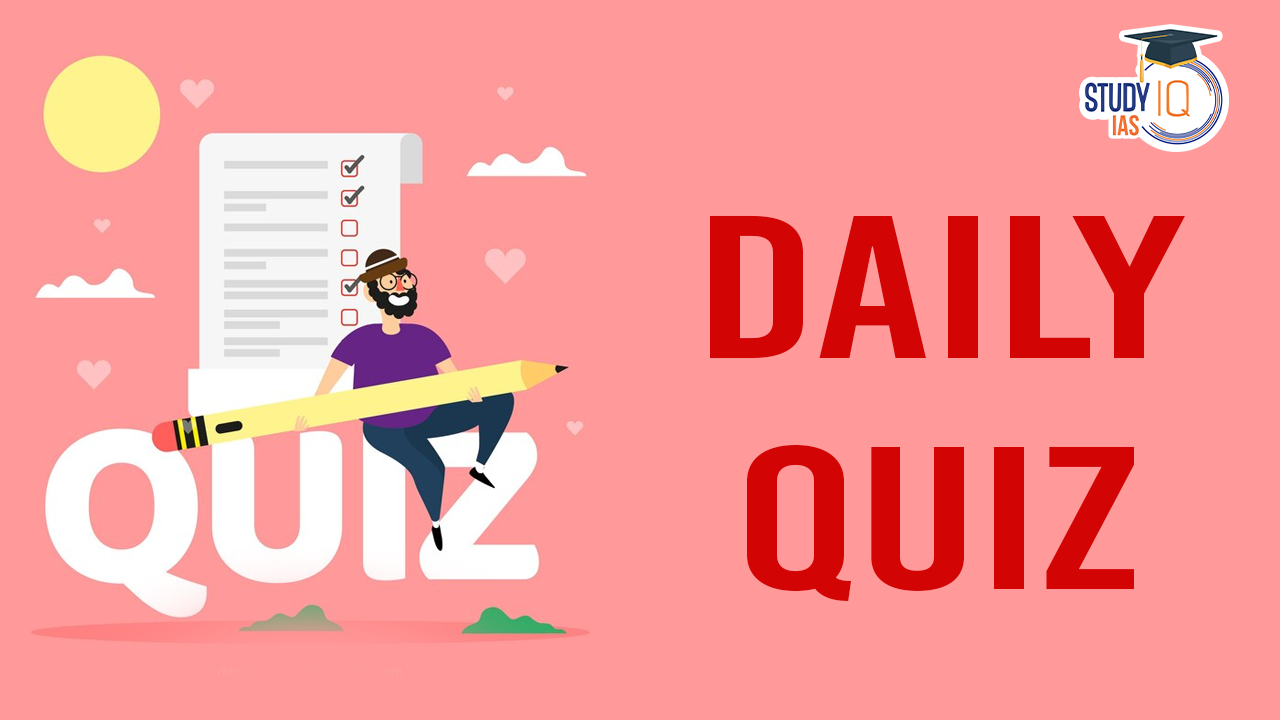Daily Quiz 16 June 2025
Quiz-summary
0 of 5 questions completed
Questions:
- 1
- 2
- 3
- 4
- 5
Information
- Click on – ‘Start Quiz’ button
- Solve Questions
- Click on ‘Next’ button
- Click on ‘Finish Quiz’ button
- Now click on ‘View Questions’ button – here you will see solutions and links.
- The test contains a total of 5 questions.
- Click on the most appropriate option to mark it as your answer.
- You will be awarded Two marks for each correct answer.
- You can change your answer by clicking on some other option.
- A Number list of all questions appears at the top side of the screen.
- You can access the questions in any order by clicking on the question number given on the number list.
- You can use rough sheets while taking the test.
- Do not use calculators, log tables, dictionaries, or any other printed/online reference material during the test.
- Do not click the button “Finish Quiz” before completing the test. A test once submitted cannot be resumed.
You have already completed the quiz before. Hence you can not start it again.
Quiz is loading...
You must sign in or sign up to start the quiz.
You have to finish following quiz, to start this quiz:
- 1
- 2
- 3
- 4
- 5
- Answered
- Review
-
Question 1 of 5
1. Question
1 pointsConsider the following statements regarding the Eurasian Otter:
1. It is listed as Critically Endangered under the IUCN Red List.
2. It is a fully aquatic mammal found only in high-altitude lakes.
3. In India, it is protected under Schedule II of the Wildlife Protection Act, 1972.
4. It has special adaptations like the ability to close ears and nostrils underwater.
Which of the statements given above is/are correct?Correct
Answer: B
Statement 1 is Incorrect. The Eurasian Otter (Lutra lutra) is listed as Near Threatened under the
IUCN Red List, not Critically Endangered. However, its population is declining in many regions due
to habitat destruction and water pollution.
Statement 2 is Incorrect. The Eurasian Otter is semiaquatic, meaning it lives both on land and in
water. It is found in rivers, lakes, coastal areas, wetlands, and not just high-altitude lakes.
Statement 3 is Correct. The Eurasian Otter is listed under Schedule II, which gives it moderate
protection under Indian law.
Statement 4 is Correct. The otter has evolved adaptations for aquatic life such as the ability to
close its ears and nostrils underwater to prevent water from entering while diving. It also has dense
fur to keep warm in cold water.Incorrect
Answer: B
Statement 1 is Incorrect. The Eurasian Otter (Lutra lutra) is listed as Near Threatened under the
IUCN Red List, not Critically Endangered. However, its population is declining in many regions due
to habitat destruction and water pollution.
Statement 2 is Incorrect. The Eurasian Otter is semiaquatic, meaning it lives both on land and in
water. It is found in rivers, lakes, coastal areas, wetlands, and not just high-altitude lakes.
Statement 3 is Correct. The Eurasian Otter is listed under Schedule II, which gives it moderate
protection under Indian law.
Statement 4 is Correct. The otter has evolved adaptations for aquatic life such as the ability to
close its ears and nostrils underwater to prevent water from entering while diving. It also has dense
fur to keep warm in cold water. -
Question 2 of 5
2. Question
1 pointsConsider the following statements:
Statement I: India must adopt a Source-to-Sea (S2S) approach to water governance.
Statement II: Water exists in a connected hydrological continuum linking glaciers, rivers,
aquifers, and oceans.
Which one of the following is correct in respect of the above statements?Correct
Answer: (a)
Explanation: The Source-to-Sea (S2S) approach integrates upstream (glaciers, rivers) and downstream
(estuaries, seas) water governance, aiming to unify freshwater and marine conservation
under one framework.
The Reason correctly highlights the interconnected nature of water — from glaciers and
rivers to aquifers and oceans — which justifies why a holistic water governance model like
S2S is essential.
Hence, Statement II explains Statement I accurately, supporting the need for integrated water
resource management in the face of climate change, pollution, and water stress.Incorrect
Answer: (a)
Explanation: The Source-to-Sea (S2S) approach integrates upstream (glaciers, rivers) and downstream
(estuaries, seas) water governance, aiming to unify freshwater and marine conservation
under one framework.
The Reason correctly highlights the interconnected nature of water — from glaciers and
rivers to aquifers and oceans — which justifies why a holistic water governance model like
S2S is essential.
Hence, Statement II explains Statement I accurately, supporting the need for integrated water
resource management in the face of climate change, pollution, and water stress. -
Question 3 of 5
3. Question
1 pointsWith reference to the High Seas Treaty (BBNJ), consider the following statements:
1. It is the first international agreement under UNCLOS to protect marine areas beyond national
jurisdictions.
2. The treaty aims to create Marine Protected Areas and enforce Environmental Impact
Assessments in international waters.
3. It requires a minimum of 100 country ratifications to come into force.
4. India has signed the treaty but is yet to ratify it.
How many of the statements given above are correct?Correct
Answer: C
Statement 1 is Correct. The BBNJ Treaty is a legally binding agreement under the United Nations
Convention on the Law of the Sea (UNCLOS), focused on conserving marine biodiversity in
Areas Beyond National Jurisdiction (ABNJ)—often referred to as the High Seas.
Statement 2 is Correct. It includes provisions for Marine Protected Areas (MPAs), Environmental
Impact Assessments (EIAs), marine genetic resources, and capacity-building to ensure
conservation in areas beyond national jurisdiction.
Statement 3 is Incorrect. The treaty requires only 60 ratifications to enter into force. As of mid-
2025, about 30+ countries have ratified it.
Statement 4 is Correct. India signed the treaty in September 2024, signalling commitment but has
not yet ratified it. Ratification would require parliamentary approval and policy harmonization
with existing laws.Incorrect
Answer: C
Statement 1 is Correct. The BBNJ Treaty is a legally binding agreement under the United Nations
Convention on the Law of the Sea (UNCLOS), focused on conserving marine biodiversity in
Areas Beyond National Jurisdiction (ABNJ)—often referred to as the High Seas.
Statement 2 is Correct. It includes provisions for Marine Protected Areas (MPAs), Environmental
Impact Assessments (EIAs), marine genetic resources, and capacity-building to ensure
conservation in areas beyond national jurisdiction.
Statement 3 is Incorrect. The treaty requires only 60 ratifications to enter into force. As of mid-
2025, about 30+ countries have ratified it.
Statement 4 is Correct. India signed the treaty in September 2024, signalling commitment but has
not yet ratified it. Ratification would require parliamentary approval and policy harmonization
with existing laws. -
Question 4 of 5
4. Question
1 pointsConsider the following statements regarding the Vibrant Villages Programme – Phase 2
(VVP-2.0):
1. It is 100% Centre-funded and aims to develop border villages.
2. It covers only the Himalayan and north-eastern states.
3. The programme also aims to counter outmigration from border areas.
4. The total financial outlay under VVP-2.0 is less than ₹3,000 crores.Which of the statements given above is/are correct?
Correct
Answer: A
Statement 1 is Correct. VVP 2.0 is fully funded by the central government to develop border
villages with critical infrastructure, livelihood support, and connectivity in strategic areas.
Statement 2 is Incorrect. Initially focused on Himalayan Border States, Phase 2 now includes non-
Himalayan border states like Punjab, Rajasthan, Gujarat, and Uttar Pradesh. Hence, it is pan-
India along all land borders.
Statement 3 is Correct. One of the key objectives is to discourage migration from border areas by
creating livelihood opportunities, thus strengthening border security and habitation.
Statement 4 is Incorrect. The total approved financial outlay under VVP-2.0 is ₹6,839 crore, much
more than ₹3,000 crore.Incorrect
Answer: A
Statement 1 is Correct. VVP 2.0 is fully funded by the central government to develop border
villages with critical infrastructure, livelihood support, and connectivity in strategic areas.
Statement 2 is Incorrect. Initially focused on Himalayan Border States, Phase 2 now includes non-
Himalayan border states like Punjab, Rajasthan, Gujarat, and Uttar Pradesh. Hence, it is pan-
India along all land borders.
Statement 3 is Correct. One of the key objectives is to discourage migration from border areas by
creating livelihood opportunities, thus strengthening border security and habitation.
Statement 4 is Incorrect. The total approved financial outlay under VVP-2.0 is ₹6,839 crore, much
more than ₹3,000 crore. -
Question 5 of 5
5. Question
1 pointsWith reference to the Malta Golden Passport Scheme, consider the following statements:
1. It allowed wealthy foreigners to acquire Maltese and, thereby, EU citizenship through
investments.
2. It was upheld by the European Court of Justice as lawful under EU treaties.
3. The scheme was criticized for enabling tax evasion and security risks.
4. It was struck down by the European Court in 2025.
Which of the statements given above is/ are correct?Correct
Answer: B
Statement 1 is Correct. The scheme allowed individuals to gain Maltese citizenship by investing a
minimum amount (up to €1 million), effectively providing EU citizenship rights such as travel,
work, and residence across the EU.
Statement 2 is Incorrect. The European Court of Justice (ECJ) struck down the scheme in April
2025, calling it incompatible with EU values, especially on citizenship integrity and security
screening.
Statement 3 is Correct. Several EU countries and watchdogs criticized the scheme for lack of
transparency, money laundering risks, and possible tax evasion, especially since it bypassed strict
residency and vetting norms.Statement 4 is Correct. The ECJ invalidated Malta’s Golden Passport programme in 2025,
marking a significant development in the EU's stance against citizenship-by-investment.Incorrect
Answer: B
Statement 1 is Correct. The scheme allowed individuals to gain Maltese citizenship by investing a
minimum amount (up to €1 million), effectively providing EU citizenship rights such as travel,
work, and residence across the EU.
Statement 2 is Incorrect. The European Court of Justice (ECJ) struck down the scheme in April
2025, calling it incompatible with EU values, especially on citizenship integrity and security
screening.
Statement 3 is Correct. Several EU countries and watchdogs criticized the scheme for lack of
transparency, money laundering risks, and possible tax evasion, especially since it bypassed strict
residency and vetting norms.Statement 4 is Correct. The ECJ invalidated Malta’s Golden Passport programme in 2025,
marking a significant development in the EU's stance against citizenship-by-investment.
Results
0 of 5 questions answered correctly
Your time:
Time has elapsed
You have reached 0 of 0 points, (0)
| Average score |
|
| Your score |
|
Categories
- Not categorized 0%
| Pos. | Name | Entered on | Points | Result |
|---|---|---|---|---|
| Table is loading | ||||
| No data available | ||||
Sharing is caring!


 Daily Quiz 18 September 2025
Daily Quiz 18 September 2025

























